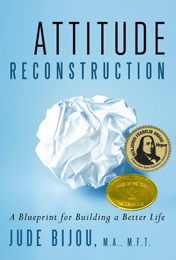Why does my husband chew his food so loudly? Why won’t that driver move out of the fast lane? Why do I have to take a class I’ll never use in my career? Why is it impossible to find a decent apartment? Maggie, a mom with a ten-year old daughter, found herself repeatedly frustrated. Jenny just wouldn’t make her bed, even though it would take her less than three minutes.
Maggie’s problem was not her daughter, but her own expectations. It was her “shoulds” that were causing her aggravation. The emotion behind frustration is anger. Maggie’s unexpressed anger manifested in her intolerance of Jenny’s resistance to making her bed. Putting our expectations on others is a habit that keeps us feeling frustrated. In addition, it puts other people off, and diminishes the amount of love we feel. Rather than continuing to stew in frustration, here are some simple things you can do.
Express your anger that underlies the frustration physically. Find a safe place where you can release the pent up energy constructively – that hot, surging, tightening sensation in your body — in a non-damaging way. (You’ll only feel embarrassed until the satisfaction and benefit become obvious.) Kick leaves, stomp through the house, push against a doorjamb, or shout into a pillow. Move the energy out of your body. Do it hard, fast, and with abandon. Maggie remembered Jenny’s temper tantrums as an infant, and used that image to inspire herself to go into the garage and really let it roll. Make sounds and grunts, because emotions are beyond the realm of word. If you use words, yell something like, “I feel so frustrated!”
Accept what is. The best way to do this is to remind yourself, over and over, that:
“People and things are the way they are, not the way I want them to be,”
“This is the way it is,”
or “That’s the way they are.”
When repeated with focus and enthusiasm, your frustration turns into amused acceptance. Maggie personalized it, “Jenny is the way she is, not the way I want her to be. Jenny doesn’t clean up her room on her own.”After repeating these words for a few minutes, it became a fact, instead of a big deal.
Pinpoint what feels frustrating, and look within to decide what you need to say and do about the specific event to honor yourself and all involved. Maybe it’s best to say nothing. Maybe it’s best to take a stand. Maybe it’s best to initiate a discussion. Maggie decided she needed to talk with Jenny, and come up with reasonable consequences when she didn’t make her bed.
Say something. Acceptance does not mean passivity. First accept and then, speak up as needed. Make sure it’s about what’s true for you, and not laced with finger-pointing and global generalizing. Rather than telling Jenny, “You’re a slob,” Maggie said, “Dad and I want the house to stay in good order, and your part in helping our family reach that goal is to make your bed every day. What do you think should happen on the days you don’t make your bed?” Together they decided she would help with the dinner dishes on days she didn’t make her bed.
Practice letting go and enjoying what is. Take the path of least resistance, even thought in your perfect world you’d do it differently. At those times, remind yourself of the larger perspective. Maggie could have dealt with her frustration by remembering how much she’d hated making her bed when she was a kid. That could have led her to decide that when Sally didn’t make her bed, it wasn’t the end of the world. She could just close the bedroom door. Follow through with what you say you’ll do.
By employing a couple of these simple suggestions, Maggie was able to turn her anger and frustration into genuine acceptance. Much to her surprise, she found that she felt less frustrated in other areas of her life. That is because frustration flees when we accept that people and situations are the way they are, not the way we want them to be. Rather than believing the world should conform to our view, we have the attention to focus on other things, such as counting our blessings, enjoying the beautiful day, or marveling at what a wonderful child we have.






